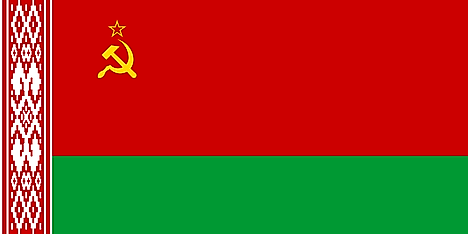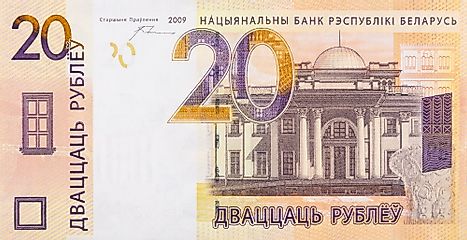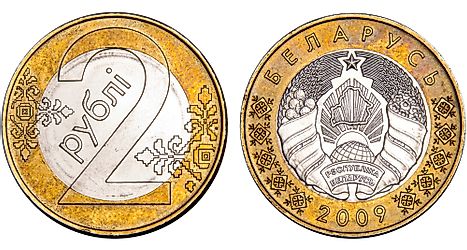Flags, Symbols & Currency of Belarus
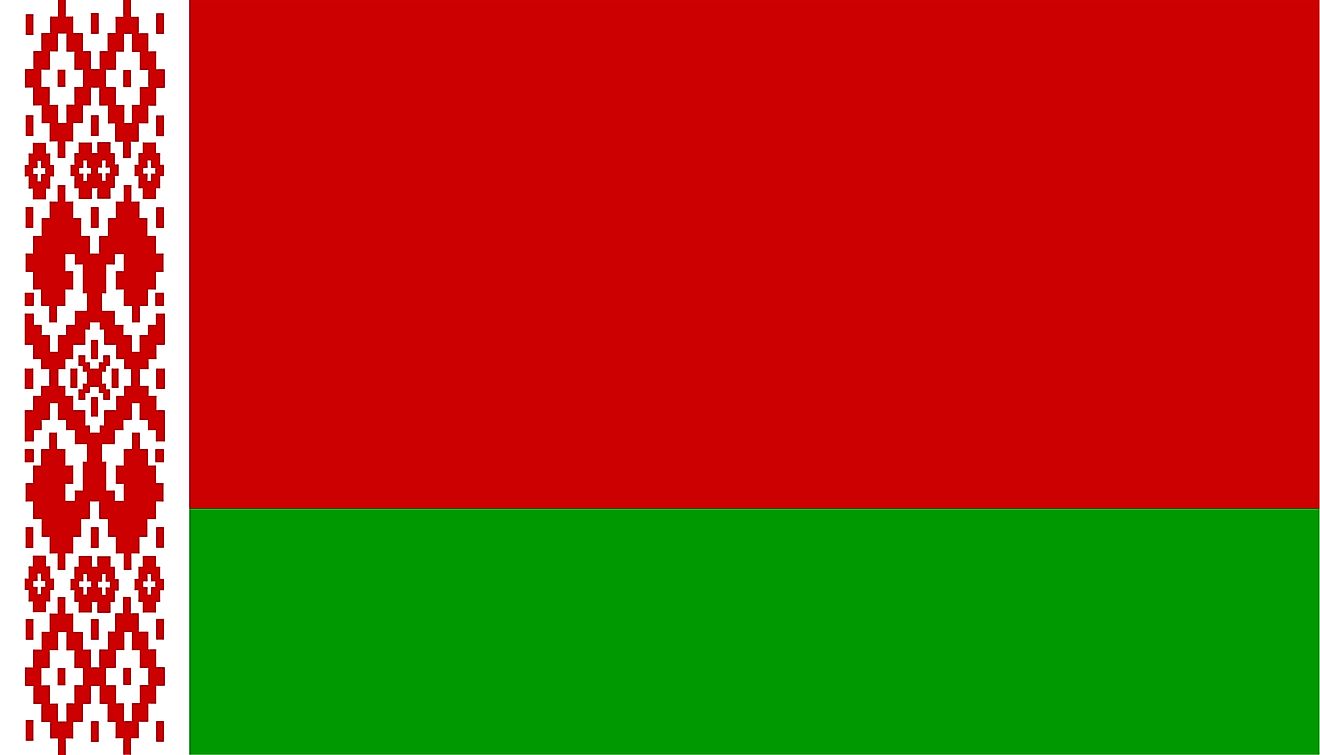
The Belarus flag was officially adopted on June 7, 1995. The current design on the Belarus flag is a modification of the flag used during 1951 and approved by a May 1995 referendum. It was introduced by the State Committee for Standardisation on February 10, 2012. The flag was designed by Mikhail Husyev and the decorative red and white Belarusian national ornamentation was designed by Matrona Markevich.
The national flag of Belarus is rectangular and features a red horizontal band (top) and a green horizontal band, covering one-half the width of the red band. A white vertical stripe on the hoist side bears the Belarusian national ornamentation in red. The red band color recalls the past struggles from oppression; while the green band represents hope and the many forests of the country. The decorative national ornamentation is derived from the local plants and flowers and is a traditional design on garments and woven cloth, commonly used in Belarus. The flag has a width-to-length proportion ratio of 1:2.
History of the Flag of Belarus
Before the Soviet-era, there were several flags used by Belarus during the early 20th century. Its first flag was in plain white connotating the nation’s name: “White Russia”. A red horizontal stripe was later added through the center of the flag. An all-red flag of the Lithuanian-Byelorussian SSR was used in 1919. In the same year, the flag was modified to include the gold-lettering. This version of the flag was used until 1927, after which the lettering was modified. The newly modified design was used for ten years and after this, the design was again changed to include the hammer, sickle, and red-star. This version of the flag was replaced by the Soviet-era flag in 1951. The Byelorussian Soviet Socialist Republic Flag was first adopted on December 25, 1951. This flag had unequal horizontal stripes of red and light green; with the golden hammer and sickle and star of communism on the red stripe of the flag. The Belorussian flag was the first flag designed in the Soviet Union to include the distinctive national ornamentation. After the fall of the communist government in 1991, the old white-red-white flag was readopted. On June 7, 1995, the old Soviet flag design was readopted and the hammer and sickle and star emblems were henceforth omitted.
Symbols of Belarus
The National Coat of Arms of Belarus
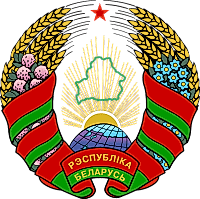
The coat of arms of Belarus (considered an emblem) replaced the historic Pahonia arms in 1995. It is composed of a red and green ribbon wrapped around stalks of wheat and flax flowers. The ribbon meets the base of the emblem, where the name “Republic of Belarus” (in Belarusian) is inscribed in golden letters. In the middle of the emblem, the rays of sunshine through an outline of the country, which hovers above a globe depicting part of Eurasia in purple and the waters in blue. At the top of the emblem is a red five-pointed star.
National Anthem
- Anthem Title: "My Belarusy" ("The State Anthem of The Republic of Belarus")
- Music Composer: Niescier Sakalowski
- Lyricist: Michas Klimkovic and Uladzimir Karyzna
- Date of Adoption: September 24, 1955 (only music) and July 2, 2002 (with lyrics)
"My Belarusy"("The State Anthem of The Republic of Belarus") is the national anthem of the Republic of Belarus. It was adopted om September 24, 1955 as the regional anthem of the Byelorussian Soviet Socialist Republic. The music of the anthem of Byelorussian SSR's regional anthem was composed by Niescier Sakalowski and the lyrics were written by Michas Klimkovic. After the Soviet Union's dissolution in 1992, the music composed by Niescier Sakalowski was retained and a new lyrics authored by Michas Klimkovic and Uladzimir Karyzna were officially adopted by a Presidential decree on July 2, 2002.
My Belarusy (Belarusian)
Мы, беларусы – мірныя людзі,
Сэрцам адданыя роднай зямлі,
Шчыра сябруем, сілы гартуем
Мы ў працавітай, вольнай сям’і.
Прыпеў:
Слаўся, зямлі нашай светлае імя,
Слаўся, народаў братэрскі саюз!
Наша любімая маці-Радзіма,
Вечна жыві і квітней, Беларусь!
Разам з братамі мужна вякамі
Мы баранілі родны парог,
У бітвах за волю, бітвах за долю
Свой здабывалі сцяг перамог!
Прыпеў:
Дружба народаў – сіла народаў –
Наш запаветны, сонечны шлях.
Горда ж узвіся ў ясныя высі,
Сцяг пераможны – радасці сцяг!
Прыпеў:
The State Anthem of The Republic of Belarus
We, Belarusians, are peaceful people,
Wholeheartedly devoted to our Motherland.
We are faithful friends, growing up
Living in a hardworking and independent family.
Chorus:
Glory to the blessed name of our land,
Glory to the brotherly union of peoples!
Our dearly beloved Motherland,
May you live long and prosper, Belarus!
Together with our brothers, we for centuries
Courageously defended our home's threshold.
In battles for freedom, and battles for our lot
We have won our banners of victory!
Chorus:
Friendship of peoples is the strength of peoples
And it is our sacred sunlit path.
Proudly we fly in the clear blue skies,
The banner of victory, the sunshine's flag!
Chorus:
The Currency of Belarus is the Belarusian ruble
The official currency of Belarus is the Belarusian ruble (Br, BYN). The ruble's subdivisions consist of 100 kopeks.
Coins
As a result of the Belarusian ruble redenomination in 2016, the first series of coins came into circulation that year. The coin denominations are 1, 2, 5, 10, 20 and 50 kopeks, and 1 and 2 rubles. For coins up to the denomination of five, copper-plated steel is the main component. The other denominations of coins are struck in brass-plated steel. The national emblem of Belarus appears on all the coins.
Banknotes
The first ruble notes were introduced in 1992 while the introduction of the second ruble banknotes took place in 2000. The third ruble notes came into existence in 2016 with the denominations of 5, 10, 20, 50, 100, 200, and 500 rubles. De La Rue Company prints these notes. The Belarusian ruble and euro banknotes have similar designs.
History of Currency In Belarus
The first ruble was introduced and used from 1992-2000. Since there was no capacity or license to print the Soviet banknotes, Belarus opted to print the country's national currency to simplify the cash circulation. The currency received different name proposals, but eventually, the word ruble was made its official name.
The introduction of the second ruble took place in 2000 and was in use until 2016. Essentially, the second ruble was a redenomination involving the removal of the three zeros in the first ruble. In 1994, President Alexander Lukashenko suggested monetary integration with Russia. In addition to the idea, there was a suggestion to introduce a combined currency for the Union of Belarus and Russia. In 2008, an implementation took place in a different way when the Central Bank of Belarus announced the tie between the Belarusian ruble and the United States dollar, leaving out the Russian ruble. Consequently, Stanislav Bogdankevich, the previous chairperson of the bank, argued that the decision was politicized in the sense that there was a plan to hike prices of gas and oil exports to Belarus.
The third ruble was introduced in 2016 and it is used in Belarus today. There was a parallel circulation of both kinds of rubles (old and new) starting from July to December 2016. During this period, the government of Belarus also brought coins into circulation for the first time. From July 1, 2016, denominations of banknotes and coins came into circulation.
